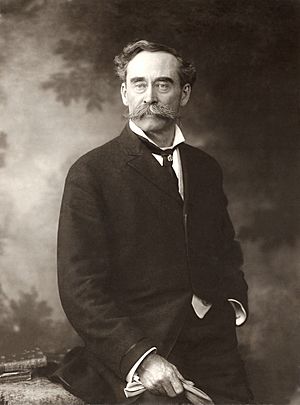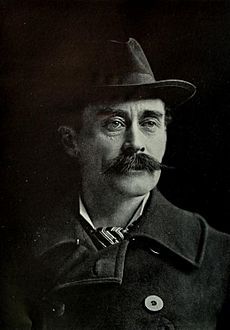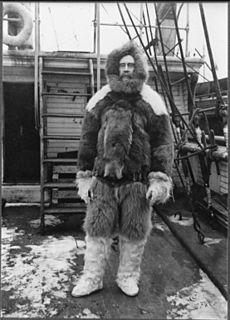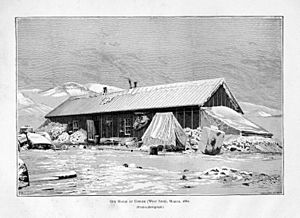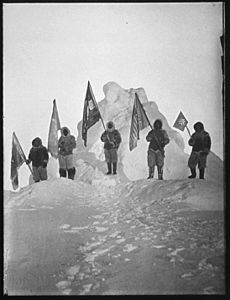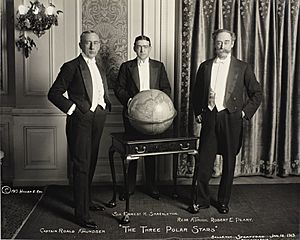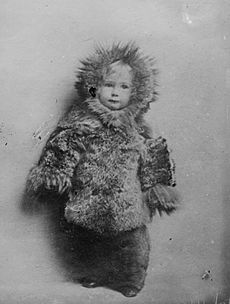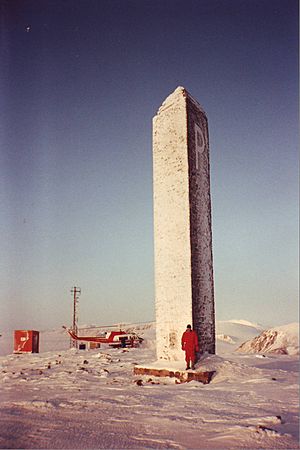Robert Peary facts for kids
Quick facts for kids
Robert Peary
|
|
|---|---|
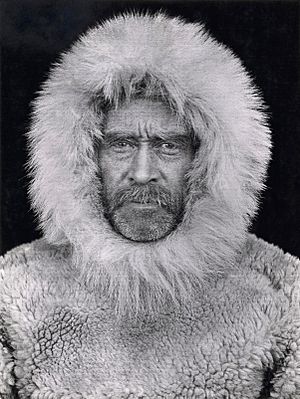
At Cape Sheridan on Ellesmere Island, 1909
|
|
| Born |
Robert Edwin Peary
May 6, 1856 Gallitzin, Pennsylvania, U.S.
|
| Died | February 20, 1920 (aged 63) Washington, D.C., U.S.
|
| Resting place | Arlington National Cemetery |
| Alma mater | Bowdoin College |
| Known for | Claim to have reached the geographic North Pole on his travels with Matthew Henson. |
| Spouse(s) | |
| Children | 4 |
| Awards |
|
| Military career | |
| Allegiance | United States of America |
| Branch | |
| Service years | 1881–1911 |
| Rank | Rear admiral |
| Unit | Civil Engineer Corps |
Robert Edwin Peary Sr. (/ˈpɪəri/; May 6, 1856 – February 20, 1920) was an American explorer and officer in the United States Navy who made several expeditions to the Arctic in the late 19th and early 20th centuries. He is best known for, in April 1909, leading an expedition that claimed to be the first to have reached the geographic North Pole.
Peary was born in Gallitzin, Pennsylvania, but, following his father's death at a young age, was raised in Portland, Maine. He attended Bowdoin College, then joined the United States Coast and Geodetic Survey as a draftsman. He enlisted in the navy in 1881 as a civil engineer. In 1885, he was made chief of surveying for the Nicaragua Canal, which was never built. He visited the Arctic for the first time in 1886, making an unsuccessful attempt to cross Greenland by dogsled. In the Peary expedition to Greenland of 1891–1892, he was much better prepared, and by reaching Independence Fjord in what is now known as Peary Land, he proved conclusively that Greenland was an island. He was one of the first Arctic explorers to study Inuit survival techniques. During an expedition in 1894, he was the first Western explorer to reach the Cape York meteorite and its fragments, which were then taken from the native Inuit population who had relied on it for creating tools. During that expedition, Peary deceived six indigenous individuals, including Minik Wallace, to travel to America with him by promising they would be able to return with tools, weapons and gifts within the year. This promise was unfulfilled and four of the six Inuit died of illnesses within a few months.
On his 1898–1902 expedition, Peary set a new "Farthest North" record by reaching Greenland's northernmost point, Cape Morris Jesup. Peary made two more expeditions to the Arctic, in 1905–1906 and in 1908–1909. During the latter, he claimed to have reached the North Pole. Peary received several learned society awards during his lifetime, and, in 1911, received the Thanks of Congress and was promoted to rear admiral. He served two terms as president of The Explorers Club before retiring in 1911.
Peary's claim to have reached the North Pole was widely debated along with a competing claim made by Frederick Cook, but eventually won widespread acceptance. In 1989, British explorer Wally Herbert concluded Peary did not reach the pole, although he may have come within 60 mi (97 km).
Contents
Early life, education, and career
Robert Edwin Peary was born on May 6, 1856, in Gallitzin, Pennsylvania to Charles N. and Mary P. Peary. After his father died in 1859, Peary and his mother moved to Portland, Maine. After growing up there, Peary attended Portland High School (Maine) where he graduated in 1873. Peary made his way to Bowdoin College, some 36 mi (58 km) to the north, where he was a member of the Delta Kappa Epsilon fraternity and the Phi Beta Kappa honor society. He was also part of the rowing team. He graduated in 1877 with a civil engineering degree.
From 1878 to 1879, Peary lived in Fryeburg, Maine. During that time, he made a profile survey from the top of Fryeburg's Jockey Cap Rock. The 360-degree survey names the larger hills and mountains visible from the summit. After Peary's death, his boyhood friend, Alfred E. Burton, suggested that the profile survey be made into a monument. It was cast in bronze and set atop a granite cylinder and erected to his memory by the Peary family in 1938.
After college, Peary worked as a draftsman making technical drawings at the U.S. National Geodetic Survey office in Washington, D.C. He joined the United States Navy and on October 26, 1881, was commissioned in the Civil Engineer Corps, with the relative rank of lieutenant. From 1884 to 1885, he was an assistant engineer on the surveys for the Nicaragua Canal and later became the engineer in charge. As reflected in a diary entry he made in 1885, during his time in the Navy, he resolved to be the first man to reach the North Pole.
In April 1886, he wrote a paper for the National Academy of Sciences proposing two methods for crossing Greenland's ice cap. One was to start from the west coast and trek about 400 mi (640 km) to the east coast. The second, more difficult path, was to start from Whale Sound at the top of the known portion of Baffin Bay and travel north to determine whether Greenland was an island or if it extended all the way across the Arctic. Peary was promoted to the rank of lieutenant commander on January 5, 1901, and to commander on April 6, 1902.
Initial Arctic expeditions
Peary made his first expedition to the Arctic in 1886, intending to cross Greenland by dog sled, taking the first of his own suggested paths. He was given six months' leave from the Navy, and he received $500 from his mother to book passage north and buy supplies. He sailed on a whaler to Greenland, arriving in Godhavn on June 6, 1886. Peary wanted to make a solo trek, but Christian Maigaard, a young Danish official, convinced him he would die if he went out alone. Maigaard and Peary set off together and traveled nearly 100 mi (160 km) due east before turning back because they were short on food. This was the second-farthest penetration of Greenland's ice sheet at the time. Peary returned home knowing more of what was required for long-distance ice trekking.
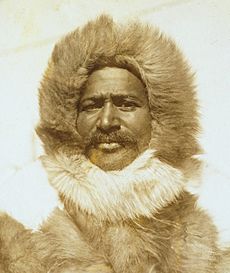
Back in Washington attending with the US Navy, in November 1887 Peary was ordered to survey likely routes for a proposed Nicaragua Canal. To complete his tropical outfit he needed a sun hat. He went to a men's clothing store where he met 21-year-old Matthew Henson, a black man working as a sales clerk. Learning that Henson had six years of seagoing experience as a cabin boy, Peary immediately hired him as a personal valet.
On assignment in the jungles of Nicaragua, Peary told Henson of his dream of Arctic exploration. Henson accompanied Peary on every one of his subsequent Arctic expeditions, becoming his field assistant and "first man", a critical member of his team.
Second Greenland expedition
In the Peary expedition to Greenland of 1891–1892, Peary took the second, more difficult route that he laid out in 1886: traveling farther north to find out whether Greenland was a larger landmass extending to the North Pole. He was financed by several groups, including the American Geographic Society, the Philadelphia Academy of Natural Sciences (now the Academy of Natural Sciences of Drexel University), and the Brooklyn Institute of Arts and Sciences. Members of this expedition included Peary's aide Henson, Frederick A. Cook, who served as the group's surgeon; the expedition's ethnologist, Norwegian skier Eivind Astrup; bird expert and marksman Langdon Gibson, and John M. Verhoeff, who was a weatherman and mineralogist. Peary also took his wife along as dietitian, though she had no formal training. Newspaper reports criticized Peary for bringing his wife.
On June 6, 1891, the party left Brooklyn, New York, in the seal hunting ship SS Kite. In July, as Kite was ramming through sheets of surface ice, the ship's iron tiller suddenly spun around and broke Peary's lower leg; both bones snapped between the knee and ankle. Peary was unloaded with the rest of the supplies at a camp they called Red Cliff, at the mouth of MacCormick Fjord at the north west end of Inglefield Gulf. A dwelling was built for his recuperation during the next six months. Josephine stayed with Peary. Gibson, Cook, Verhoeff, and Astrup hunted game by boat and became familiar with the area and the Inuit.
Unlike most previous explorers, Peary had studied Inuit survival techniques; he built igloos during the expedition and dressed in practical furs in the native fashion. By wearing furs to preserve body heat and building igloos, he was able to dispense with the extra weight of tents and sleeping bags when on the march. Peary also relied on the Inuit as hunters and dog-drivers on his expeditions. He pioneered the system of using support teams and establishing supply caches for Arctic travel, which he called the "Peary system". The Inuit were curious about the Americans and came to visit Red Cliff. Josephine was bothered by the Inuit body odor from not bathing, their flea infestations, and their food. She studied the people and kept a journal of her experiences. In September 1891, Peary's men and dog sled teams pushed inland onto the ice sheet to lay caches of supplies. They did not go farther than 30 mi (48 km) from Red Cliff.
In 1891, Peary shattered his leg in a shipyard accident but it healed by February 1892. By April 1892, he made some short trips with Josephine and an Inuit dog sled driver to native villages to purchase supplies. On May 3, 1892, Peary finally set out on the intended trek with Henson, Gibson, Cook, and Astrup. After 150 mi (240 km), Peary continued on with Astrup. They found the 3,300 ft (1,000 m) high view from Navy Cliff, saw Independence Fjord, and concluded that Greenland was an island. They trekked back to Red Cliff and arrived on August 6, having traveled a total of 1,250 mi (2,010 km).
In 1896, Peary, a Master Mason, received his degrees in Kane Lodge No. 454, New York City.
1898–1902 expeditions
As a result of Peary's 1898–1902 expedition, he claimed an 1899 visual discovery of "Jesup Land" west of Ellesmere Island. He claimed that this sighting of Axel Heiberg Island was prior to its discovery by Norwegian explorer Otto Sverdrup's expedition around the same time. This contention has been universally rejected by exploration societies and historians. However, the American Geographical Society and the Royal Geographical Society of London honored Peary for tenacity, mapping of previously uncharted areas, and his discovery in 1900 of Cape Morris Jesup at the north tip of Greenland. Peary also achieved a "farthest north" for the western hemisphere in 1902 north of Canada's Ellesmere Island. Peary was promoted to lieutenant commander in the Navy in 1901 and to commander in 1902.
1905–1906 expedition
Peary's next expedition was supported by fundraising through the Peary Arctic Club, with gifts of $50,000 from George Crocker, the youngest son of banker Charles Crocker, and $25,000 from Morris K. Jesup, to buy Peary a new ship. The SS Roosevelt navigated through the ice between Greenland and Ellesmere Island, establishing an American hemisphere "farthest north by ship". The 1906 "Peary System" dogsled drive for the pole across the rough sea ice of the Arctic Ocean started from the north tip of Ellesmere at 83° north latitude. The parties made well under 10 mi (16 km) a day until they became separated by a storm.
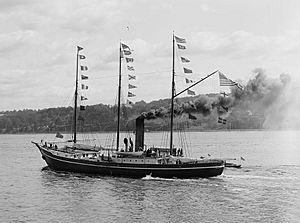
As a result, Peary was without a companion sufficiently trained in navigation to verify his account from that point northward. With insufficient food, and uncertainty whether he could negotiate the ice between himself and land, he made the best possible dash and barely escaped with his life from the melting ice. On April 20, he was no farther north than 86°30' latitude. This latitude was never published by Peary. It is in a typescript of his April 1906 diary, discovered by Wally Herbert in his assessment commissioned by the National Geographic Society. The typescript suddenly stopped there, one day before Peary's April 21 purported "farthest". The original of the April 1906 record is the only missing diary of Peary's exploration career. He claimed the next day to have achieved a Farthest North world record at 87°06' and returned to 86°30' without camping. This implied a trip of at least 72 nautical miles (133 km; 83 mi) between sleeping, even assuming direct travel with no detours.
After returning to Roosevelt in May, Peary began weeks of difficult travel in June heading west along the shore of Ellesmere. He discovered Cape Colgate, from whose summit he claimed in his 1907 book that he had seen a previously undiscovered far-north "Crocker Land" to the northwest on June 24, 1906. A later review of his diary for this time and place found that he had written, "No land visible." On December 15, 1906, the National Geographic Society of the United States, certified Peary's 1905–1906 expedition and "Farthest" with its highest honor, the Hubbard Medal. No major professional geographical society followed suit. In 1914, Donald Baxter MacMillan and Fitzhugh Green's expedition found that Crocker Land did not exist.
Claiming to reach the North Pole
On July 6, 1908, the Roosevelt departed New York City with Peary's eighth Arctic expedition of 22 men. Besides Peary as expedition commander, it included master of the Roosevelt Robert Bartlett, surgeon Dr. J.W. Goodsell, and assistants Ross Gilmore Marvin, Donald Baxter MacMillan, George Borup, and Matthew Henson. After recruiting several Inuit and their families at Cape York (Greenland), the expedition wintered near Cape Sheridan on Ellesmere Island. The expedition used the "Peary system" for the sledge journey, with Bartlett and the Inuit, Poodloonah, "Harrigan," and Ooqueah, composing the pioneer division. Borup, with three Inuit, Keshunghaw, Seegloo, and Karko, composed the advance supporting party. On February 15, Bartlett's pioneer division departed the Roosevelt for Cape Columbia, followed by 5 advance divisions. Peary, with the two Inuit, Arco and Kudlooktoo, departed on February 22, bringing to the total effort 7 expedition members, 19 Inuit, 140 dogs, and 28 sledges. On February 28, Bartlett, with three Inuit, Ooqueah, Pooadloonah, and Harrigan, accompanied by Borup, with three Inuit, Karko, Seegloo, and Keshungwah, headed North.
On March 14, the first supporting, composed of Dr. Goodsell and the two Inuit, Arco and Wesharkoupsi, party turned back towards the ship. Peary states this was at a latitude of 84°29'. On March 20, Borup's third supporting party, with three Inuit, started back to the ship. Peary states this was at a latitude of 85°23'. On March 26, Marvin, with Kudlooktoo and Harrigan, headed back to the ship, from a latitude estimated by Marvin as 86°38'. Marvin died on this return trip South. On 1 April, Bartlett's party started their return to the ship, after Bartlett estimated a latitude of 87°46'49". Peary, with two Inuit, Egingwah and Seeglo, and Henson, with two Inuit, Ootah and Ooqueah, using 5 sledges and 40 dogs, planned 5 marches over the estimated 130 nautical miles to the pole. On 2 April, Peary led the way north.
On the final stage of the journey toward the North Pole, Peary told Bartlett to stay behind. He continued with five assistants: Henson, Ootah, Egigingwah, Seegloo, and Ooqueah. No one except Henson, who had served as navigator and craftsman on the Peary expedition to Greenland of 1891–1892, was capable of making navigation observations. On April 6, 1909, Peary established Camp Jesup within 3 mi (5 km) of the pole, according to his own readings. Peary estimated the latitude as 89°57', after making an observation at approximate local noon using the Columbia meridian. Peary used a sextant, with a mercury trough and glass roof for an artificial horizon, to make measurements of the Sun. Peary claims, "I had now taken in all thirteen single, or six and one-half double, altitudes of the sun, at two different stations, in three different directions, at four different times." Peary states some of these observations were "beyond the Pole," and "...at some moment during these marches and counter-marches, I had passed over or very near the point where north and south and east and west blend into one." Henson scouted ahead to what was thought to be the North Pole site; he returned with the greeting, "I think I'm the first man to sit on top of the world," much to Peary's chagrin.
On April 7, 1909, Peary's group started their return journey, reaching Cape Columbia on April 23, and the Roosevelt on April 26. MacMillan and the doctor's party had reached the ship earlier, on March 21, Borup's party on April 11, Marvin's Inuit on April 17, and Bartlett's party on April 24. On July 18, the Roosevelt departed for home.
Upon returning to civilization, Peary learned that Dr. Frederick A. Cook, a surgeon on the Peary expedition to Greenland of 1891–1892, claimed to have reached the North pole in 1908. Despite remaining doubts, a committee of the National Geographic Society, as well as the Naval Affairs Subcommittee of the U.S. House of Representatives, credited Peary with reaching the North Pole.
A reassessment of Peary's notebook in 1988 by polar explorer Wally Herbert found it "lacking in essential data", thus renewing doubts about Peary's discovery.
Later life and death
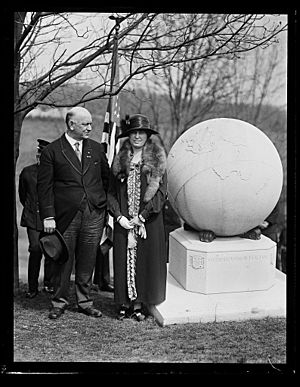
Peary was promoted to the rank of captain in the Navy in October 1910. By his lobbying, Peary headed off a move among some U.S. Congressmen to have his claim to the pole evaluated by other explorers. Eventually recognized by Congress for "reaching" the pole, Peary was given the Thanks of Congress by a special act in March 1911. By the same Act of Congress, Peary was promoted to the rank of rear admiral in the Navy Civil Engineer Corps, retroactive to April 6, 1909. He retired from the Navy the same day, to Eagle Island on the coast of Maine, in the town of Harpswell. His home there has been designated a Maine State Historic Site.
After retiring, Peary received many honors from scientific societies for his Arctic explorations and discoveries. He served twice as president of The Explorers Club, from 1909 to 1911, and from 1913 to 1916.
In early 1916, Peary became chairman of the National Aerial Coast Patrol Commission, a private organization created by the Aero Club of America. It advocated the use of aircraft to detect warships and submarines off the U.S. coast. Peary used his celebrity to promote the use of military and naval aviation, which led directly to the formation of United States Navy Reserve aerial coastal patrol units during World War I. After the war, Peary proposed a system of eight airmail routes, which became the genesis of the U.S. Postal Service's airmail system.
In 1914, Peary bought the house at 1831 Wyoming Avenue NW in the Adams Morgan neighborhood of Washington, D.C., where he lived until his death on February 20, 1920. He began renovating the house in 1920, shortly before his death, after which the renovation was taken over by Josephine. Josephine sold the house in 1927, receiving a $12,000 promissory note.
He was buried in Arlington National Cemetery. Matthew Henson was honored by being re-interred nearby on April 6, 1988.
Marriage and family
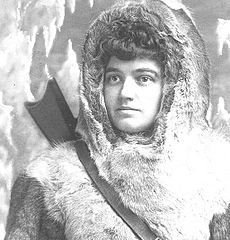
On August 11, 1888, Peary married Josephine Diebitsch, a business school valedictorian who thought that women should be more than just mothers. Diebitsch had started working at the Smithsonian Institution when she was 19 or 20 years old, replacing her father after he became ill and filling his position as a linguist. In 1886, she resigned from the Smithsonian upon becoming engaged to Peary.
The newlyweds honeymooned in Atlantic City, New Jersey, then moved to Philadelphia, where Peary was assigned. Peary's mother accompanied them on their honeymoon, and she moved into their Philadelphia apartment, which caused friction between the two women. Josephine told Peary that his mother should return to live in Maine.
They had two children together, Marie Ahnighito (born 1893) and Robert Peary, Jr. His daughter wrote several books, including The Red Caboose (1932) a children's book about the Arctic adventures published by William Morrow and Company. As an explorer, Peary was frequently gone for years at a time. In their first 23 years of marriage, he spent only three with his wife and family.
Peary and his aide, Henson, both had relationships with Inuit women outside of marriage and fathered children with them. Peary appears to have started a relationship with Aleqasina (Alakahsingwah) when she was about 14 years old. She bore him at least two children, including a son called Kaala, Karree, or Kali. French explorer and ethnologist Jean Malaurie was the first to report on Peary's descendants after spending a year in Greenland in 1951–52.
S. Allen Counter, a Harvard neuroscience professor interested in Henson's role in the Arctic expeditions, went to Greenland in 1986. He found Peary's son Kali and Henson's son Anaukaq, then octogenarians, and some of their descendants. Counter arranged to bring the men and their families to the United States to meet their American relatives and see their fathers' gravesites. In 1991, Counter wrote about the episode in his book, North Pole Legacy: Black, White, and Eskimo (1991). He also gained national recognition of Henson's role in the expeditions. A documentary by the same name was also released. Wally Herbert also noted the relationship and children in his book The Noose of Laurels, published in 1989.
Treatment of the Inuit
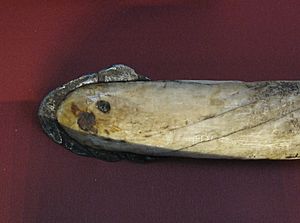
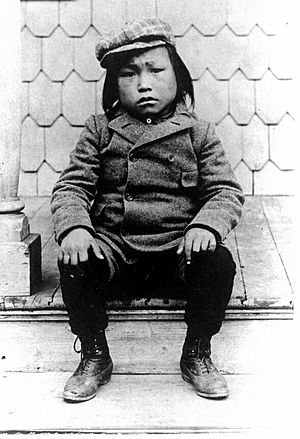
Peary has received criticism for his treatment of the Inuit, for fathering children with Aleqasina and for bringing back a small group of Inughuit Greenlandic Inuit to the United States along with the Cape York meteorite, which was of significant local importance as the only source of iron for tools and Peary sold for $40,000 in 1897.
Working at the American Museum of Natural History, anthropologist Franz Boas had requested that Peary bring back an Inuit for study. During his expedition to retrieve the Cape York meteorite, Peary convinced six individuals, including a man named Qisuk and his child Minik, to travel to America with him by promising they would be able to return with tools, weapons and gifts within the year. Peary left the people at the museum when he returned with the Cape York meteorite in 1897, where they were kept in damp, humid conditions unlike their homeland. Within a few months, four died of tuberculosis; their remains were dissected and the bones of Qisuk were put on display after Minik was shown a fake burial.
Peary eventually helped Minik travel home in 1909, though it is speculated that this was to avoid any bad press surrounding his anticipated celebratory return after reaching the North Pole.
Legacy
Several United States Navy ships have been named USS Robert E. Peary. The Peary–MacMillan Arctic Museum at Bowdoin College is named for Peary and fellow Arctic explorer Donald Baxter MacMillan. In 1986, the United States Postal Service issued a 22-cent postage stamp in honor of Peary and Henson;
Peary Land, Peary Glacier, Peary Nunatak and Cape Peary in Greenland, Peary Bay and Peary Channel in Canada, as well as Mount Peary in Antarctica, are named in his honor. The lunar crater Peary, appropriately located at the moon's north pole, is also named after him.
Camp Peary in York County, Virginia is named for Admiral Peary. Originally established as a Navy Seabee training center during World War II, it was repurposed in the 1950s as a Central Intelligence Agency training facility. It is commonly called "The Farm".
Admiral Peary Vocational Technical School, located in a neighboring community very close to his birthplace of Cresson, PA, was named for him and was opened in 1972. Today the school educates over 600 students each year in numerous technical education disciplines.
A section of U.S. Route 22 in Cambria County, Pennsylvania is named the Admiral Peary Highway
Major General Adolphus Greely, leader of the ill-fated Lady Franklin Bay Expedition from 1881 to 1884, noted that no Arctic expert questioned that Peary courageously risked his life traveling hundreds of miles from land, and that he reached regions adjacent to the pole. After initial acceptance of Peary's claim, he later came to doubt Peary's having reached 90°.
In his book Ninety Degrees North, polar historian Fergus Fleming describes Peary as "undoubtedly the most driven, possibly the most successful and probably the most unpleasant man in the annals of polar exploration".
In 1932, an expedition was made by Robert Bartlett and Marie Ahnighito Peary Stafford, Peary's daughter, on the Effie M. Morrissey to erect a monument to Peary at Cape York, Greenland.
Honors
Medals
- American Geographical Society, Cullum Geographical Medal (1896)
- American Geographical Society, Charles P. Daly Medal (1902)
- National Geographic Society, Hubbard Medal (1906)
- Royal Geographical Society of London, special great gold medal
- National Geographic Society of Washington, the special great gold medal
- Geographical Society of Philadelphia, great gold medal
- Chicago Geographical Society, Helen Culver medal
- Imperial German Geographical Society, Nachtigall gold medal
- Royal Italian Geographical Society, King Humbert gold medal
- Imperial Austrian Geographical Society
- Hungarian Geographical Society gold medal
- Royal Belgian Geographical Society gold medal
- Royal Geographical Society of Antwerp gold medal
- Spanish Campaign Medal
Honorary degrees
- Bowdoin College - Doctor of laws
- Edinburgh University - Doctor of laws
Honorary memberships
- New York Chamber of Commerce honorary member.
- Pennsylvania Society Honorary member
- Manchester Geographical Society Honorary membership
- Royal Netherlands Geographical Society of Amsterdam Honorary membership
Other
- Royal Scottish Geographical Society, special trophy, a replica in silver of the ships used by Hudson, Baffin, and Davis.
- Grand Officer of the Legion of Honor, awarded 1913
- In Arlington National Cemetery on April 6, 1922, the Admiral Robert Edwin Peary monument was unveiled by his daughter, Mrs. Marie Peary Stafford. Numerous government officials, including President Harding and Former United States Secretary of the Navy Edwin Denby were in attendance.
- On May 28, 1986, the United States Postal Service issued a 22 cent postage stamp in his and Matthew Henson's honor.
See also
 In Spanish: Robert Peary para niños
In Spanish: Robert Peary para niños


